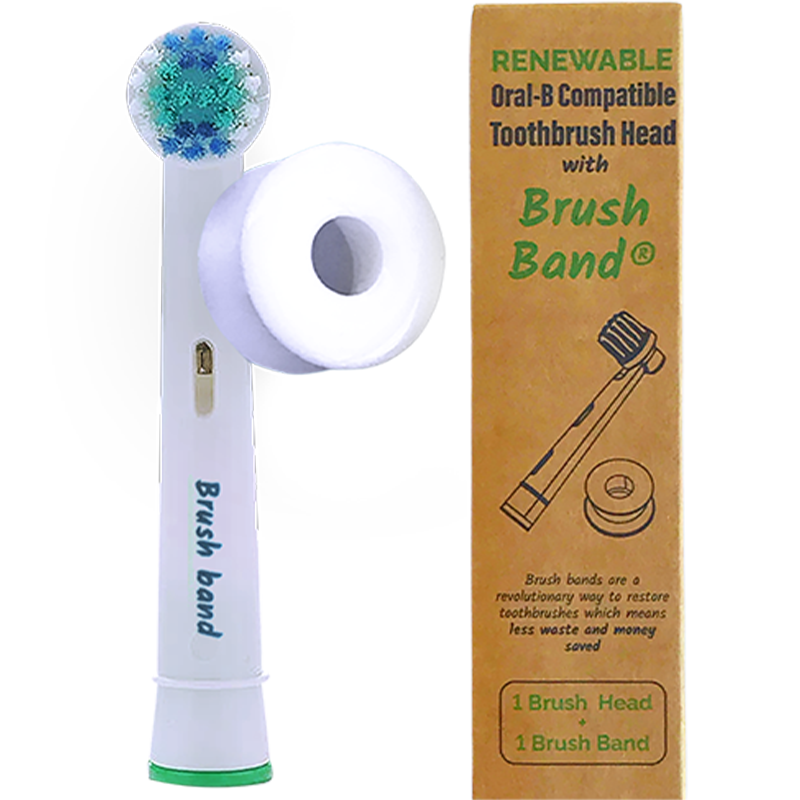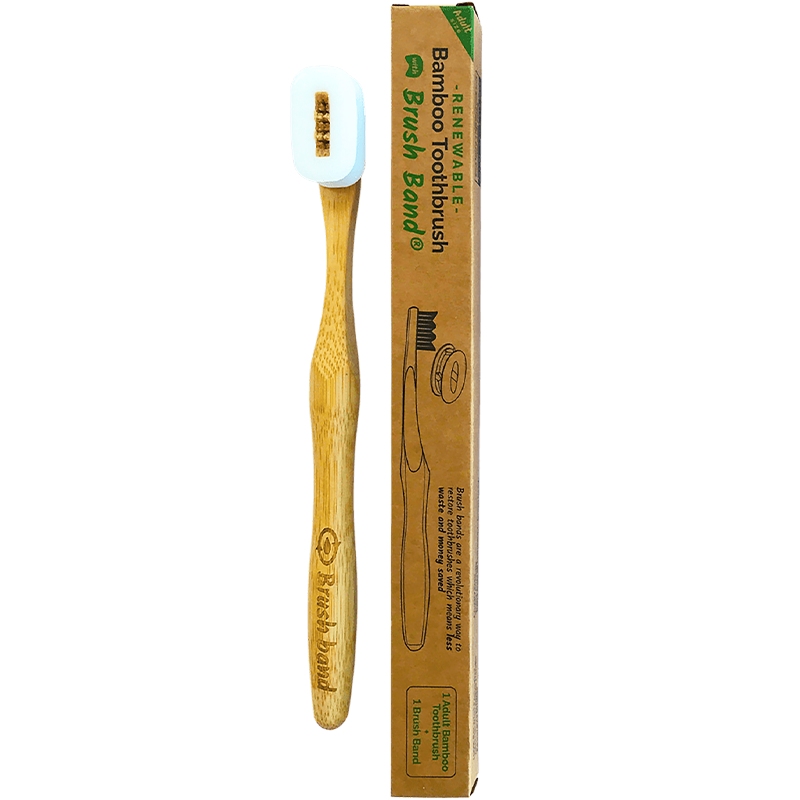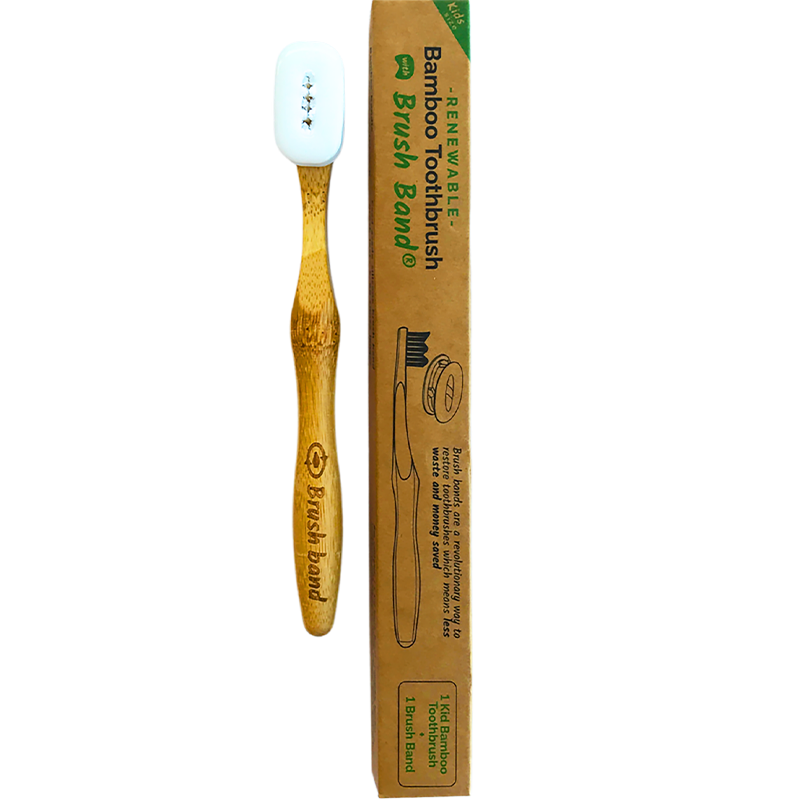Our History
Brushband Shapes for All Toothbrushes
The idea for brush bands came about from necessity. Glenn, the inventor, was tired of replacing toothbrushes that were fine except for the bristles. He also had two young kids who couldn’t help but bite on a new brush, which aged them very fast.
Glenn was concerned for the environment, and the waste this was creating. He is also a bit of a cheap ass, and hates waste for that reason too. Tired of replacing toothbrushes that were fine except for their bristles, Glenn got to work to find out ways that might restore toothbrush bristles to their original shape.
First, he tried rubber bands, but they squished the brush, were hard to put on and popped off. The wire kind of stayed on but rusted and was a hassle to get around the bristles. Dental putty was too hard to shape around the bristles. Plaster didn’t work at all. Softening bristles in boiling oil made a nasty mess in the saucepan.
Just heating in boiling water helped a bit, but some brushes didn’t work much at all. Shaped cones or caps over the bristles kept grabbing the odd bristle and bending it the wrong way like a mean-spirited wrestler. Eventually, food-grade silicon rubber could be made into a reasonable shape just slightly smaller than the brush head to squeeze the bristles back to a better state.
Since silicone can be molded, Glenn got himself a 3D printer and set about making mold after mold and band after the band from that.






The idea for brush bands came about from necessity. Glenn, the inventor, was tired of replacing toothbrushes that were fine except for the bristles. He also had two young kids who couldn’t help but bite on a new brush, which aged them very fast.
Glenn was concerned for the environment, and the waste this was creating. He is also a bit of a cheap ass, and hates waste for that reason too. Tired of replacing toothbrushes that were fine except for their bristles, Glenn got to work to find out ways that might restore toothbrush bristles to their original shape.
First, he tried rubber bands, but they squished the brush, were hard to put on and popped off. The wire kind of stayed on but rusted and was a hassle to get around the bristles. Dental putty was too hard to shape around the bristles. Plaster didn’t work at all. Softening bristles in boiling oil made a nasty mess in the saucepan.
Just heating in boiling water helped a bit, but some brushes didn’t work much at all. Shaped cones or caps over the bristles kept grabbing the odd bristle and bending it the wrong way like a mean-spirited wrestler. Eventually, food-grade silicon rubber could be made into a reasonable shape just slightly smaller than the brush head to squeeze the bristles back to a better state.
Since silicone can be molded, Glenn got himself a 3D printer and set about making mold after mold and band after the band from that.
Timeline so far
- 2020 - Pandemic hits. What if we run out of toothbrushes? No sustainable solutions. How much plastic wasted? Get to work ...
- 2021 - First prototypes show some success. Keep trying.
- 2022 - Brushband packs launched on quickly assembled website.
- 2023 - Toothbrush and Brushband packs available for first time.
History Continued. You're still reading?

He also found that a curved incline inside the band with maximum correction towards the tip with some compression compensation of the bristles provided the optimum correction. If you were interested to know. Which even if you weren’t, you’ve read it now. And you can’t go back. So there. Glenn also wrote the text for this site, and also bored his family and friends with similar brush restoration discoveries.
Glenn however quickly ran out of brushes to test on, as he could restore them faster than his family could wear them out. He restored toothbrushes from under the sink that had been cleaning tiles, kids toothbrushes, adult toothbrushes and even had a crack at paint brushes ( more on that later ). Glenn used up all the old brushes in his house by making them useable again!
Luckily, Glenn’s few remaining friends would meet him at a cafe and bring their toothbrushes for him to experiment on. The tests were very successful, restoring his friends sometimes embarrassingly aged brushes to useable again, and providing some interesting optics for the café staff. The restoration proofs were in. Brush bands were a success.
Next, Glenn asked his remote friends for a ‘brushie’. A photo of their toothbrushes. This was the sort of question that was quite expected from his remote friends and not at all the reason they were remote.
Glenn was shocked at the state of his friends brushes. He quickly moulded off a few dozen bands and sent them around the world. Well, England mainly. One in Canberra, and a few others here and there.
Wonderfully Glenn’s friends had great success restoring and maintaining their brushes effectiveness, and asked when they could get more. So he had to stop typing this paragraph and put together a website to buy these bands.
You’re read quite a lot now. Why don’t you buy a Brushband for your worn out toothbrushes:
Or just buy a toothbrush with a matching brushband

What's the goal of Brushbands?
Who are we?
Starting out with a Dad tired of replacing his kid’s toothbrushes, we’ve grown into a family company based in Melbourne Australia.
We are a small company with big dreams we will strive:

To support people worldwide who want to reduce waste and extend the usefulness of their brushes.

To see a global reduction in plastic waste from brushes.

To support local manufacturing to enable community creation and distribution of brush restoration products.

To provide brush solutions in areas of low economic advantage to improve dental health due to better access to more effective toothbrushes.
What's in the Future?
Currently, the bands are manufactured in the inventor’s (Glenn’s) home. This is a bit messy, and won’t scale up very far before the house is covered in bands and the cat learns to mix silicone rubber.
However, we are still perfecting the bands. There are a lot of toothbrushes out there, and we want to get the right combination of bands to suit the biggest number of brush types. So home manufacture with agile correction through adapting 3D printed moulds. This should be fine until we get passed about 100 bands a day. Then it’s off to find somewhere, preferably locally, to make our bands at a reasonable cost.
We will match centralised manufacturing with some local manufacturing too. We plan to license the moulds and the e-commerce store to allow people around the world to create their own bands to sell through the site, or in their community. We haven’t figured out how to do this yet.
Is this a new idea?
Well, to do this properly, we did some hard research and put together a patent application.
No: 2021901296.
We have found plenty of previous patent attempts over the last few decades to create mechanisms and devices that would have some success in restoring brushes, but they looked hard to make, hard to clean, or hard to use. Either way, we never saw them in the supermarket so they didn’t take off we guess.
Extra Brush Life seems new in that it’s a simple shaped, flexible band.
It stretches over the bristles so there’s less chance of grabbing a bristle and bending it the wrong way by accident. It’s just silicone rubber, so it’s non-toxic, heat-safe, and really easy and cheap to make and keep clean.
The inside of the band is shaped in a way to provide maximum useful correction of the tips of bristles that typically have the worst flailing and then lead to the whole bristle to flail.

